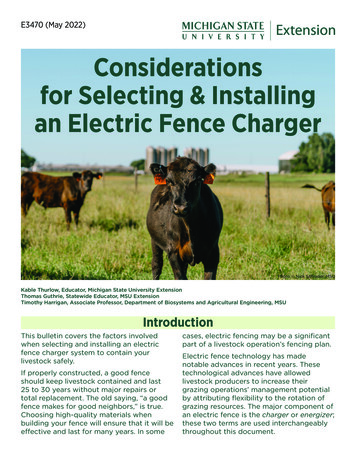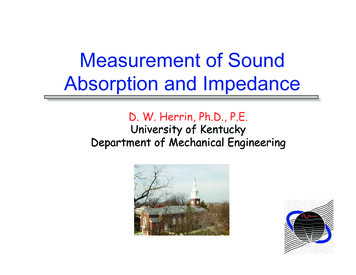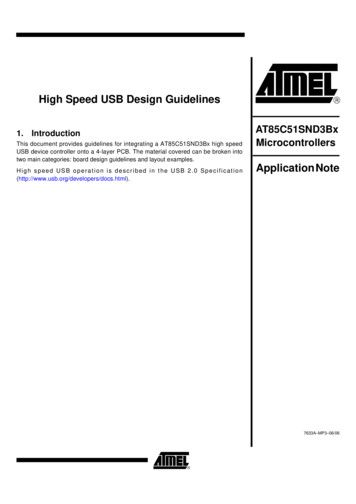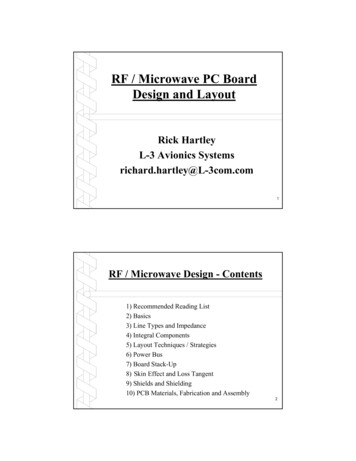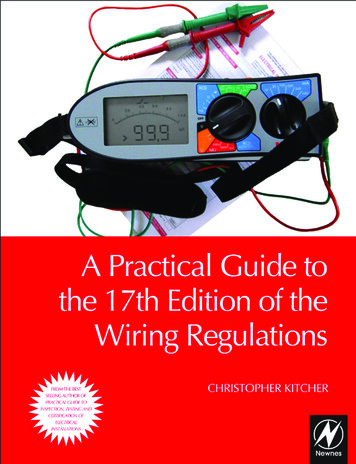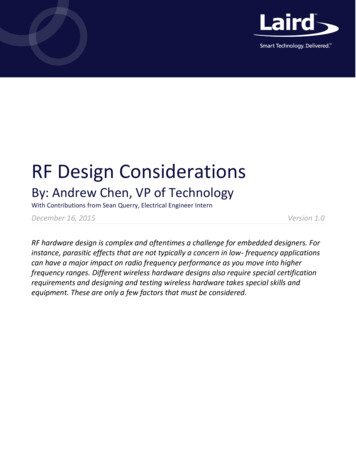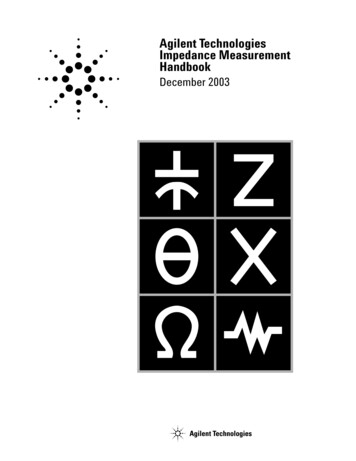
Transcription
Agilent TechnologiesImpedance MeasurementHandbookDecember 2003
This page intentionally left blank.
The Impedance Measurement HandbookA Guide to Measurement Technology and TechniquesCopyright 2000-2003 Agilent Technologies Co. LtdAll rights reserved.TABLE OF CONTENTSSECTION 1 Impedance measurement basicsParagraph 1-11-21-31-41-5Impedance .Measuring impedance .Parasitics: there are no pure R, C or L .True, effective and indicated values .Component dependency factors .1-11-31-31-41-5SECTION 2 Impedance measurement instrumentsParagraph 2-12-2Measurement methods . 2-1Operating theory of practical instruments . 2-5––––––– LF impedance measurement -52-4-62-4-72-4-8Theory of auto balancing bridge method .Key measurement functions .OSC level .DC bias .Ranging function .Level monitor function .Measurement time and averaging .Compensation function .Guarding .Grounded device measurement capability ��–– RF impedance measurement 2-7-52-7-6Theory of RF I-V measurement method .Difference between RF I-V and network analysismethods .Key measurement functions .OSC level .Test port .Calibration .Compensation .Measurement range .DC bias .i2-162-182-202-202-202-212-212-212-21
SECTION 3 Fixturing and cabling––––––– LF impedance measurement –––––––Paragraph nal configuration .Using test cables at high frequencies .Test fixtures .Agilent supplied test fixtures .User fabricated test fixtures .User test fixture example .Test cables .Agilent supplied test cables .User fabricated test cable .Test cable extension .Eliminating the stray capacitance effects –– RF impedance measurement –––––––3-63-73-7-13-8Terminal configuration in RF region .RF test fixtures .Agilent supplied RF test fixtures .Test port extension in RF region .3-123-133-143-15SECTION 4 Measurement error and compensation––––––– Basic concepts and LF impedance measurement –––––––Paragraph rement error .Calibration and compensation .Offset compensation .Open and short compensations .Precautions for open and short measurements .Open, short and load compensations .What should be used as the load? .Application limit for open, short andload compensations .Error caused by contact resistance .Measurement cable extension induced error .Practical compensation examples –– RF impedance measurement -6-64-6-74-6-84-7Calibration and compensation in RF region .Calibration .Error source model .Compensation method .Precautions for open and short measurementsin RF region .Consideration for short compensation .Calibrating load device .Electrical length compensation .Practical compensation technique .Measurement correlation and repeatability .ii4-134-134-144-154-154-164-174-184-194-19
4-7-14-7-24-7-34-7-44-7-5Variance in residual parameter value .A difference in contact condition .A difference in open and short compensation conditions .Electromagnetic coupling with a conductornear the DUT .Variance in environmental temperature .4-194-204-214-214-22SECTION 5 Impedance measurement applications and enhancementsParagraph 5Capacitor measurement .Inductor measurement .Transformer measurement .Diode measurement .MOS FET measurement .Silicon wafer C-V measurement .High frequency impedance measurementusing the probe .Resonator measurement .Cable measurements .Balanced device measurement .Battery measurement .Test signal voltage enhancement .DC bias voltage enhancement .DC bias current enhancement .Equivalent circuit analysis function and its application 5-325-34APPENDIX A The concept of a test fixture’s additional error . A-1APPENDIX B Open and short compensation . B-1APPENDIX C Open, short and load compensation . C-1APPENDIX D Electrical length compensation . D-1APPENDIX E Q measurement accuracy calculation . E-1Authors:Kazunari OkadaToshimasa SekinoAgilent Technologies Co. Ltdiii
This page intentionally left blank.iv
SECTION 1Impedance measurement basics1-1.ImpedanceImpedance is an important parameter used to characterize electronic circuits, components, andthe materials used to make components. Impedance (Z) is generally defined as the total opposition a device or circuit offers to the flow of an alternating current (AC) at a given frequency, andis represented as a complex quantity which is graphically shown on a vector plane. An impedancevector consists of a real part (resistance, R) and an imaginary part (reactance, X) as shown inFigure 1-1. Impedance can be expressed using the rectangular-coordinate form R jX or in thepolar form as a magnitude and phase angle: Z θ. Figure 1 also shows the mathematical relationship between R, X, Z and θ. In some cases, using the reciprocal of impedance is mathematically expedient. In which case 1/Z 1/(R jX) Y G jB, where Y represents admittance, G conductance, and B susceptance. The unit of impedance is the ohm (Ω), and admittance is thesiemen (S). Impedance is a commonly used parameter and is especially useful for representing aseries connection of resistance and reactance, because it can be expressed simply as a sum, R andX. For a parallel connection, it is better to use admittance (see Figure 1-2).Figure 1-1. Impedance (Z) consists of a real part (R) and an imaginary part (X)Figure 1-2. Expression of series and parallel combination of real and imaginary components1-1
Reactance takes two forms - inductive (XL) and capacitive (Xc). By definition, XL 2πfL andXc 1/(2πfC), where f is the frequency of interest, L is inductance, and C is capacitance. 2πf can besubstituted for by the angular frequency (ω:omega) to represent XL ωL and Xc 1/(ωC). Refer toFigure 1-3.Figure 1-3. Reactance in two forms - inductive (XL) and capacitive (Xc)A similar reciprocal relationship applies to susceptance and admittance. Figure 1-4 shows a typical representation for a resistance and a reactance connected in series or in parallel.The quality factor (Q) serves as a measure of a reactance’s purity (how close it is to being a purereactance, no resistance), and is defined as the ratio of the energy stored in a component to theenergy dissipated by the component. Q is a dimensionless unit and is expressed as Q X/R B/G.From Figure 1-4, you can see that Q is the tangent of the angle θ. Q is commonly applied toinductors; for capacitors the term more often used to express purity is dissipation factor (D). Thisquantity is simply the reciprocal of Q, it is the tangent of the complementary angle of θ, the angleδ shown in Figure 1-4 (d).Figure 1-4. Relationships between impedance and admittance parameters1-2
1-2.Measuring impedanceTo find the impedance, we need to measure at least two values because impedance is a complexquantity. Many modern impedance measuring instruments measure the real and the imaginaryparts of an impedance vector and then convert them into the desired parameters such as Z , θ, Y , R, X, G, B. It is only necessary to connect the unknown component, circuit, or material tothe instrument. However, sometimes the instrument will display an unexpected result (too highor too low). One possible cause of this problem is incorrect measurement technique, or the natural behavior of the unknown device. In this section, we will focus on the traditional passive components and discuss their natural behavior in the real-world as compared to their idealistic behavior.1-3.Parasitics: There are no pure R, C or LAll circuit components are neither purely resistive nor purely reactive, they are a combination ofthese impedance elements. The result is, all real-world devices have parasitics - unwanted inductance in resistors, unwanted resistance in capacitors, unwanted capacitance in inductors, etc. Ofcourse, different materials and manufacturing technologies produce varying amounts of parasitics, affecting both a component’s usefulness and the accuracy with which you can determine itsresistance, capacitance, or inductance. A real-world component contains many parasitics. Withthe combination of a component’s primary element and parasitics, a component will be like a complex circuit, if it is represented by electrical symbols as shown in Figure 1-5.Figure 1-5. Component (capacitor) with parasitics represented by an electrical equivalent circuit1-3
1-4.True, effective, and indicated valuesA thorough understanding of true, effective, and indicated values of a component, as well as theirsignificance to component measurements, is essential before you proceed with making practicalmeasurements. A true value is the value of a circuit component (resistor, inductor or capacitor) that excludesthe defects of its parasitics. In many cases, the true value can be defined by a mathematicalrelationship involving the component’s physical composition. In the real-world, true valuesare only of academic interest (Figure 1-6 (a)). The effective value takes into consideration the effects of a component’s parasitics. The effective value is the algebraic sum of the circuit component’s real and reactive vectors; thus, it isfrequency dependent (Figure 1-6 (b)). The indicated value is the value obtained with and displayed by the measurement instrument; it reflects the instrument’s inherent losses and inaccuracies. Indicated values alwayscontain errors when compared to true or effective values. They also vary intrinsically fromone measurement to another; their differences depend on a multitude of considerations.Comparing how closely an indicated value agrees with the effective value under a defined setof measurement conditions lets you judge the measurement’s quality (Figure 1-6 (c)).The effective value is what we want to know, and the goal of measurement is to have the indicated value to be as close as possible to the effective value.Figure 1-6. True, effective, and indicated values1-4
1-5.Component dependency factorsThe measured impedance value of a component depends on several measurement conditions, suchas frequency, test signal level, and so on. Effects of these component dependency factors are different for different types of materials used in the component, and by the manufacturing processused. The following are typical dependency factors that affect measurement results.Frequency:Frequency dependency is common to all real-world components because of the existence of parasitics. Not all parasitics affect the measurement, but some prominent parasitics determine thecomponent’s frequency characteristics. The prominent parasitics will be different when theimpedance value of the primary element is not the same. Figures 1-7 through 1-9 shows the typical frequency response for real-world resistors, inductors, and capacitors.Figure 1-7. Resistor frequency responseFigure 1-8. Inductor frequency response1-5
Figure 1-9. Capacitor frequency responseTest signal level:The test signal (AC) applied may affect the measurement result for some components. For example, ceramic capacitors are test signal voltage dependent as shown in Figure 1-10 (a). This dependency varies depending on the dielectric constant (K) of the material used to make the ceramiccapacitor.Cored-inductors are test signal current dependent due to the electromagnetic hysteresis of thecore material. Typical AC current characteristics are shown in Figure 1-10 (b).Figure 1-10. Test signal level (AC) dependencies of ceramic capacitors and cored-inductorsDC bias:DC bias dependency is very common in semiconductor components such as diodes and transistors.Some passive components are also DC bias dependent. The capacitance of a high-K type dielectricceramic capacitor will vary depending on the DC bias voltage applied, as shown in Figure 1-11 (a).In the case of cored-inductors, the inductance varies according to the DC bias current flowingthrough the coil. This is due to the magnetic flux saturation characteristics of the core material.Refer to Figure 11 (b).1-6
Figure 1-11. DC bias dependencies of ceramic capacitors and cored-inductorsTemperature:Most types of components are temperature dependent. The temperature coefficient is an important specification for resistors, inductors and capacitors. Figure 1-12 shows some typical temperature dependencies that affect ceramic capacitors with different dielectrics.Other dependency factors:Other physical and electrical environments, e.g., humidity, magnetic fields, light, atmosphere,vibration, and time may change the impedance value. For example, the capacitance of a high-Ktype dielectric ceramic capacitors decreases with age as shown in Figure 1-13.Figure 1-12. Temperature dependency ofceramic capacitorsFigure 1-13. Aging dependency of ceramiccapacitors1-7
This page intentionally left blank.
SECTION 2Impedance measurement instruments2-1.Measurement methodsThere are many measurement methods to choose from when measuring impedance, each of whichhas advantages and disadvantages. You must consider your measurement requirements and conditions, and then choose the most appropriate method, while considering such factors as frequency coverage, measurement range, measurement accuracy, and ease of operation. Your choice willrequire you to make tradeoffs as there is not a single measurement method that includes all measurement capabilities. Figure 2-1 shows six commonly used impedance measurement methods,from low frequencies up to the microwave region. Table 2-1 lists the advantages and disadvantages of each measurement method, the corresponding Agilent typical instruments, their applicable frequency range, and the typical applications for each method. Considering only measurement accuracy and ease of operation, the auto balancing bridge method is the best choice for measurements up to 110 MHz. For measurements from 100 MHz to 3 GHz, the RF I-V method hasthe best measurement capability, and from 3 GHz and up the network analysis is the recommended technique.Bridge methodWhen no current flows through the detector (D), the value ofthe unknown impedance Zx can be obtained by the relationshipof the other bridge elements. Various types of bridge circuits,employing combinations of L, C, and R components as thebridge elements, are used for various applications.Resonant methodWhen a circuit is adjusted to resonance by adjusting a tuning capacitor C, the unknown impedance Lx and Rx valuesare obtained from the test frequency, C value, and Q value.Q is measured directly using a voltmeter placed across thetuning capacitor. Because the loss of the measurementcircuit is very low, Q values as high as 1000 can be measured. Other than the direct connection shown here, seriesand parallel connections are available for a wide range ofimpedance measurements.Figure 2-1. Impedance measurement method (1 of 3)2-1
I-V methodAn unknown impedance Zx can be calculated from measured voltage and current values. Current is calculatedusing the voltage measurement across an accuratelyknown low value resistor, R. In practice a low-loss transformer is used in place of R to prevent the effects causedby placing a low value resistor in the circuit. The transformer, however, limits the low end of the applicable frequency range.RF I-V methodWhile the RF I-V measurement method is based onthe same principle as the I-V method, it is configured in a different way by using an impedancematched measurement circuit (50 Ω) and a precision coaxial test port for operation at higher frequencies. There are two types of the voltmeter andcurrent meter arrangements; which are suited to lowimpedance and high impedance measurements.Impedance of the device under test (DUT) is derivedfrom measured voltage and current values, as illustrated. The current that flows through the DUT iscalculated from the voltage measurement across aknown low value resistor, R. In practice, a low losstransformer is used in place of the low value resistor, R. The transformer limits the low end of theapplicable frequency range.Network analysis methodThe reflection coefficient is obtained by measuringthe ratio of an incident signal to the reflected signal.A directional coupler or bridge is used to detect thereflected signal and a network analyzer is used tosupply and measure the signals. Since this methodmeasures reflection at the DUT, it is usable in thehigher frequency range.Figure 2-1. Impedance measurement method (2 of 3)2-2
Auto balancing bridge methodThe current, flowing through the DUT, also flows through resistorR. The potential at the “L” point is maintained at zero volts (thuscalled a “virtual ground”), because the current through R balances with the DUT current by operation of the I-V converteramplifier. The DUT impedance is calculated using voltage measurement at High terminal and that across R.Note: In practice, the configuration of the auto balancing bridgediffers for each type of instrument.Generally LCR meters, in a low frequency range typicallybelow 100 kHz, employ a simple operational amplifier forits I-V converter. This type of instrument has a disadvantage in accuracy, at high frequencies, because of performance limits of the amplifier. Wideband LCR meters andimpedance analyzers employ the I-V converter consistingof sophisticated null detector, phase detector, integrator(loop filter) and vector modulator to ensure a high accuracy for a broad frequency range over 1 MHz. This type ofinstrument can attain to a maximum frequency of 110 MHz.Figure 2-1. Impedance measurement method (3 of 3)2-3
Table 2-1. Common impedance measurement angeTypical AgilentproductsCommonapplicationBridgemethodHigh accuracy (0.1%typ.).Wide frequencycoverage by usingdifferent types ofbridges.Low cost.Need to be manuallybalanced.Narrow frequencycoverage with asingle instrument.DC to300 MHzNoneStandardlabResonantmethodGood Q accuracy up tohigh Q.Need to be tuned toresonance.Low impedancemeasurement accuracy.10 kHz to70 MHzNoneHigh Qdevicemeasurement.I-VmethodGrounded devicemeasurement.Suitable to probetype test needs.Operating frequencyrange is limited bytransformer used inprobe.10 kHz to100 MHzNoneGroundeddevicemeasurement.RF I-VmethodHigh accuracy (1%typ.) and wideimpedance range at highfrequencies.Operating frequencyrange is limited bytransformer used intest head.1 MHz to3 GHz4287ARF4395A 43961A component4396B 43961A measurement.E4991ANetworkanalysismethodHigh frequencyRange.Good accuracy whenthe unknownimpedance is close tothe characteristicimpedanceRecalibration requiredwhen the measurementfrequency is changed.Narrow impedancemeasurement range.300 lancingbridgemethodWide frequencycoverage from LF to HF.High accuracy overa wide impedancemeasurement range.Grounded devicemeasurementHigher frequency rangesnot available.20 Hz to110 MHz4284A4294A4294A 42941A(*1)4294A 42942A(*1)GenericcomponentmeasurementNote:(*1) GroundeddevicemeasurementAgilent Technologies currently offers no instruments for the bridge method and the resonant method shaded in theabove table.2-4
2-2.Operating theory of practical instrumentsThe operating theory and key functions of the auto balancing bridge instrument are discussed inthe paragraphs 2-3 through 2-4-8. A discussion of the RF I-V instrument is described in paragraphs 2-5 through 2-7-6.2-3.Theory of auto balancing bridge methodThe auto balancing bridge method is commonly used in modern LF impedance measurementinstruments. Its operational frequency range has been extended up to 110 MHz. A detailed discussion of the operating theory of a practical instrument using Agilent 4294A precision impedanceanalyzer as an example will now be discussed. Table 2-2 lists the 4294A’s key specifications, andFigure 2-2 shows the simplified block diagram of the 4294A analog section.Table 2-2. Agilent 4294A precision impedance analyzer key specificationsTest signalFrequency: 40 Hz to 110 MHz, 1 mHz resolutionSignal level: 5 mV to 1 V rmsImpedance measurementparameters Z , Y , θ, R, X, G, B, L, C, D, QImpedance measurementrange3 mΩ to 500 MΩBasic measurementaccuracy0.08% of readingDisplayColor graphic display, 6 digitsDC bias0 V to 40 V, 0 mA to 100 mAFigure 2-2. Simplified analog-section block diagram for the Agilent 4294A precisionimpedance analyzer2-5
The measurement circuit is functionally divided into following three sections.The signal source section generates the test signal applied to the unknown device. The frequency of the test signal (fm) is variable from 40 Hz to 110 MHz, and the maximum frequency resolution is 1 mHz. A microprocessor controlled frequency synthesizer is employed to generate thesehigh-resolution test signals. The output signal level, variable from 5 mV to 1 V, is adjusted usingan attenuator. Figure 2-3 shows a diagram of the signal source section. In addition to generatingthe test signal which is fed to the DUT, the internally used reference signals are also generated inthis section.The auto balancing bridge section balances the range resistor current with the DUT current tomaintain a zero potential at the low terminal. Figure 2-4 (a) shows a simplified block diagram ofthe bridge section. The detector D detects potential at the low terminal and controls both magnitude and phase of the OSC2 output, so that the detected potential becomes zero. The actual balancing operation is shown in Figure 2-4 (b). When the bridge is “unbalanced”, the null detectordetects an error current and the phase detectors, at the next stage, separate it into 0 and 90 vector components. The output signals of the phase detectors go through loop filters (integrators)and are applied to the modulator to drive the 0 and 90 component signals. The resultant signalis amplified and fed back through range resistor Rr to cancel the current through the DUT, therefore no error current flows into the null detector. This balancing operation is performed automatically over the full frequency range of 40 Hz to 110 MHz.The vector ratio detector section measures two vector voltages across the DUT (Edut) and rangeresistor Rr (Err) series circuit (Figure 2-5). Since the range resistor value is known, measuringtwo voltages will give the impedance vector Zx of the DUT by Zx Rr (Edut/Err). Selector S1selects either the Edut or Err signal so that these signals alternately flow identical paths to eliminate tracking errors between the two signals. Each vector voltage is measured using an A to Dconverter and separated into its 0 and 90 components by digital processing.Figure 2-3. Signal source section block diagram2-6
Figure 2-4. Auto balancing bridge section block diagramFigure 2-5. Vector ratio detector section block diagram2-7
2-4.Key measurement functionsThe following discussion describes the key measurement functions for advanced impedance measurement instruments. Thoroughly understanding these measurement functions will eliminatethe confusion sometimes caused by the measurement results obtained.2-4-1. OSC levelThe oscillator output signal is output through the Hc
1-2. Measuring impedance To find the impedance, we need to measure at least two values because impedance is a complex quantity. Many modern impedance measuring instruments measure the real and the imaginary


